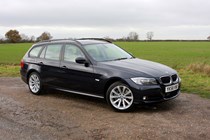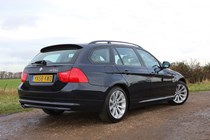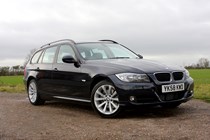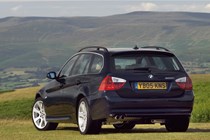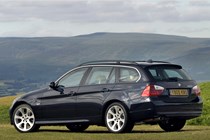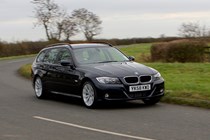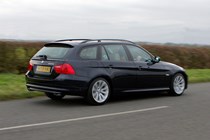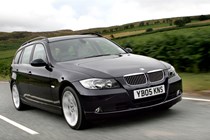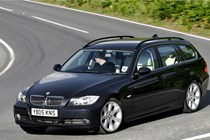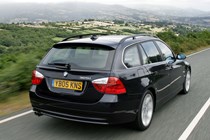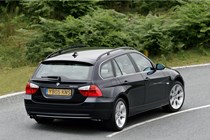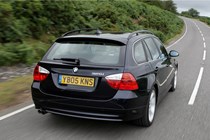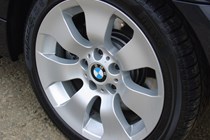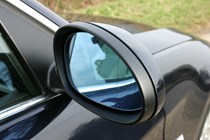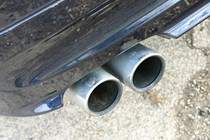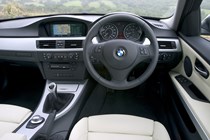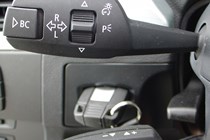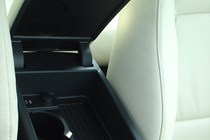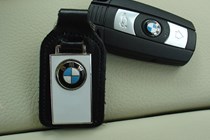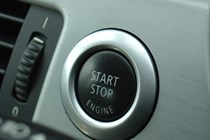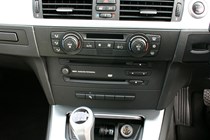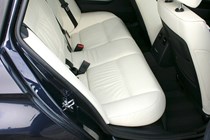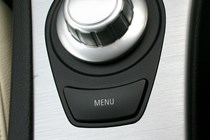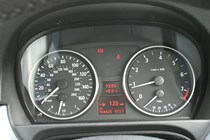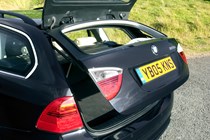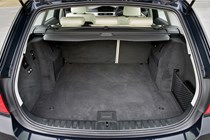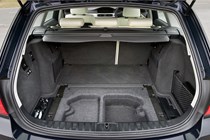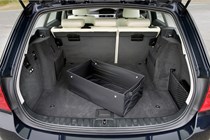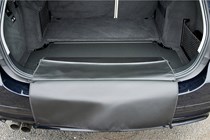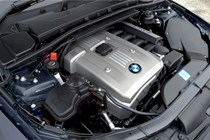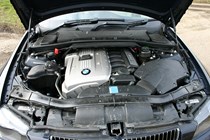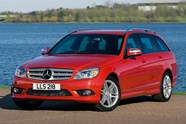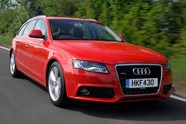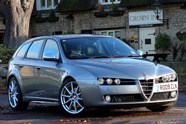
BMW 3-Series Touring review
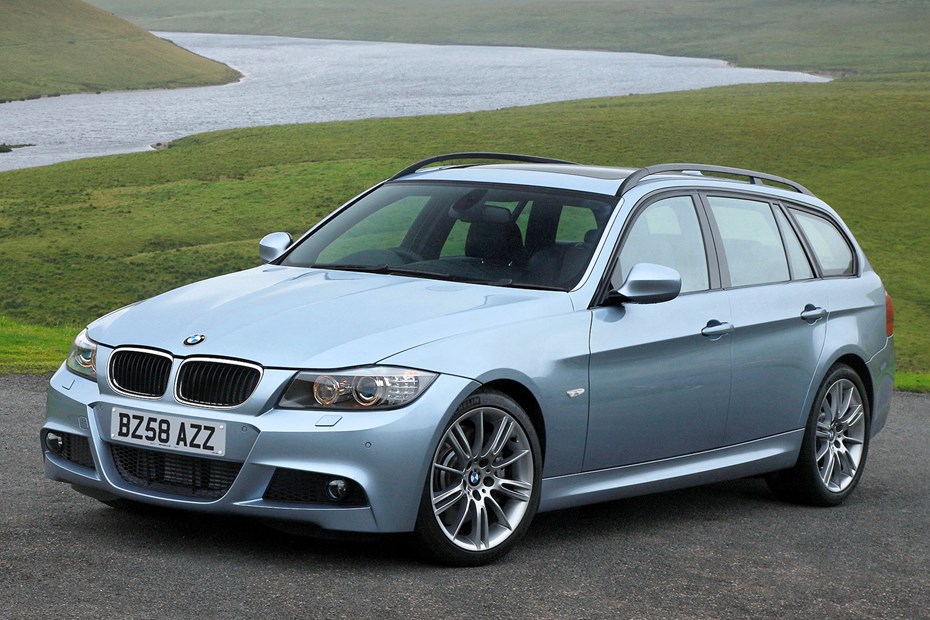
At a glance
| Price new | £21,750 - £39,985 |
|---|---|
| Used prices | £896 - £7,926 |
| Road tax cost | £35 - £710 |
| Insurance group | 21 - 38 |
Get an insurance quote with

|
|
| Fuel economy | Not tested to latest standards |
| Range | 416 - 832 miles |
| View full specs for a specific version | |
Available fuel types
Petrol
Diesel
Pros & cons
- Great to drive
- Well equipped trim levels
- Relatively easy to maintain
- Small, for an estate
- Smaller engines can be unreliable
- Most on the market are diesel
BMW 3-Series Touring (05-12) rivals
Overview
If you’re looking for a used car that’s a little bigger than a typical hatchback and offers a satisfying driving experience, the 2005-2012 BMW 3 Series Touring is an excellent choice. Introduced alongside the E90 generation of 3 Series, the Touring shares that sweet spot of modern foundations and refinement, with a wide variety of engines and simpler tech to maintain.
It’s not a bulky estate car, either. Despite providing that big-car feel of refinement on the motorway that makes the 3 Series so popular with company car drivers, it’s about the same length as a Ford Focus Estate. There’s a trade-off though – the load area isn’t quite as flexible as estate versions of a front-wheel drive hatchback. Even so, the lack of a loading lip or intrusion from lights, the availability of an opening rear window, and 40:20:40 split rear seat that folds for a flat load area, makes it more useful than previous generations of 3 Series Touring.
When buying used at this sort of budget there are lots of alternatives – if you prefer more robust practicality a Skoda Octavia Estate or Audi A4 Avant might be worth exploring, and the BMW’s main rival, the Mercedes C-Class Estate, offers a slightly more mature image. It’s not that much better in terms of load space though. The main rival for a used 3 Series Touring is the same age of 5 Series Touring, since the extra cost new is all but forgotten at this age.
For a compact, practical and fun all-rounder, the BMW 3 Series Touring is hard to beat as a used buy. There’s a catch though – even the newest E90s are over a decade old now. To get the best, keep reading for the Parkers guide to buying a second hand BMW 3 Series Touring.
BMW 3 Series Touring (E91) buying guide
This was a premium model when launched, and the quality of fit and finish generally reflects that but BMW has always erred on the lighter side of engineering and trim. This means a used BMW 3 Series is likely to show more wear than than a similar age of Audi or Mercedes. Buttons and trim covers can break or be lost, and electrical issues are more common than with rivals – though often minor. The best 2005-2012 3 Series to buy used is a six cylinder petrol model, and if you do want a diesel the next generation – F30 – has improved reliability and a reasonable selection of ULEZ-compliant Euro 6 models.
There are high-performance models – though BMW didn’t offer an M3 Touring until 2023, Alpina offered tuned-up B3 (and D3) versions. There is no xDrive AWD model despite availability in LHD markets – if you want to avoid the rear-wheel drive slide in winter with a cheap used BMW, you’ll want a BMW X3 or 2012-2019 3 Series Touring.
For a generally good balance of reliability, economy and performance we would choose a six-cylinder petrol model – 323i to 330i. If ULEZ is not a concern, the 325d is a solid choice with a torquey, pleasant-sounding engine that is slightly less sought-after than the 330d. Four-cylinder models use slightly less fuel in congestion, but the engines have more issues as they get older. To find out what to look for, keep reading.
2005-12 3 Series Touring known faults and common problems
On the back of BBC Watchdog investigation, in May 2018 BMW announced it was recalling 312,000 petrol- and diesel-engined cars built between March 2007 and August 2011 due to potentially defective battery wiring. This generation of 3 Series Touring is one of the ranges could be affected, so it’s vital to check with a BMW dealer whether the work to fix the problem has been undertaken before buying a used example. Recalls for diesel EGR valves and heater blower motor wiring also apply.
1. Four-cylinder petrol – 318i, 320i N46
One of the weakest links in the BMW 3 Series’ reputation, the N46 and N43 four-cylinder engines suffered problems early on. Due to the design and components, those issues can resurface after repair unless the owner has been remarkably diligent.
Pre-2007 models use the N46, which has issues with the cam chain tensioner, the timing chain itself, and failure of the Valvetronic units. All of these issues manifest as rattling noises of different forms near the front of the engine, and if ignored will result in poor running and misfires.
The chain guides can break up and block oilways in the engine, so loud rattles at startup mean walk away. A chattering sound at idle and as RPM builds is usually a failing Valvetronic unit, which may also cause poor running.
2. N43 petrol engine – Nikasil bores and timing chain failure
The 2007-on N43 engine has similar weaknesses, but the timing chain was moved to the back near the windscreen, making replacement a gearbox-out job that costs thousands. You’ll hear any rattles warning of failure by listening as the engine is started, but stand near the windscreen and listen near the centre just ahead of the wipers.
This engine was also prone to the Nikasil cylinder treatment failing if high-sulphur fuels were used. Listen for a harsh ‘tick’ in time with the engine’s RPM.
3. Four-cylinder diesel – 318d, 320d M47 and N47
When new the 318d and 320d earned high praise, as impressively powerful yet economical options. As an older used car, the difference in cost between a six-cylinder 325d is less important than the greater reliability of the bigger engine. If you find an appealing 318d or 320d, it’s worth checking the service history thoroughly.
On both engines, look for excessive smoke under high revs (even if it’s clean when idling), check the coolant condition and look for evidence of leaks, and check the oil for diesel-smells and signs of it it being diluted.
As always with a modern diesel, favour cars that have done higher annual mileages even if they’ve had a period laid-up over the pandemic. Checking the MOT history can give a good idea of how many miles the car has covered each year – more miles suggests more use at higher speeds, which is better for the DPF and emissions system.
4. M47 diesel – swirl flaps
Variable-length intakes on the BMW 318d and 320d pre-2007 mean swirl flaps – these butterfly valves are fitted inside the intake manifold and as well as being a fragile mechanical component that can shed parts into the engine in extreme circumstances, they get fouled up with carbon deposits. If the car feels sluggish above 2,000rpm there’s a good chance they need attention. Some owners remove them, with a small impact on low-speed efficiency.
5. N47 diesel – timing chains (again)
Yes, everyone’s favourite BMW issue – the N47 has the same underspecified timing chains and guides as several other BMW engines of this period, but because it’s a diesel it’s harder to hear them rattle. This is a more refined engine than the M47 however, so before choosing a used 318d or 320d, try several examples to get a feel for what the engine should sound like.
The timing chain is not near the radiator, as you’d expect. It’s at the back near the windscreen. Listen for rattles from a cold start, and if there is a harsher, slap sound it will need serious work. You can also check for timing chain wear indirectly by looking for a camshaft position sensor fault with a simple diagnostic tool.
6. All engines – VANOS and Valvetronic components
Variable valve timing has been part of BMW’s engine design for a long time, and VANOS issues are well-known and understood by most of the trade and enthusiastic owners. Most BMW 3 Series engines use a later system called Valvetronic, which can adjust the valve lift as well as the timing.
Generally a fault with the system will result in poor running and a diagnostic code, but that may also be down to a faulty sensor. What keeps the system healthy is clean oil, regularly changed, but degraded timing chain guides can also block the solenoids that control oil pressure to VANOS modules.
As long as the car has no fault codes showing, and sounds smooth and free of rattles, the VANOS system should be okay. Valvetronic is generally reliable as long as the oil has not been neglected, but failure in operation will log a code and check engine light, and cause a reduction in power.
7. Manual gearbox, dual-mass fly wheel and propshaft bearings
BMW’s manual gearboxes are slick-shifting and precise. Some models have a restrictor in the clutch release that if you drive aggressively, can feel like the clutch slips – check for slip in a high gear on and incline, not with aggressive high-RPM changes. This technique can also damage the dual-mass flywheel, so it’s not recommended.
Baulking shifts may be the result of clutch release failure, or loss of oil – look for leaks under the car, particularly around the join between the gearbox and engine, and the point where the propshaft connects. If there’s a vibration from higher RPM when decelerating – such as downhill in gear – that can suggest a problem with the dual-mass flywheel. Leaks from the engine sump can also contaminate the clutch via the bellhousing.
More obvious vibration or rumbles could be down to problems with the propshaft joints or centre bearing, particularly on higher-mileage cars. Thumping when moving away from a standstill is often wear in the differential, which can be expensive to repair but often easily replaced with a used part.
A cheap 3 Series in a desirable spec with a worn clutch might have a silver lining – if you get the clutch and flywheel replaced, you’re a long way into the work involved in replacing the timing chain and guides. You would need to be saving several thousand over a known-good example however.
8. BMW E90 automatic gearbox – ZF or GM?
BMW used two basic designs of automatic gearbox in this generation of 3 Series. Many four-cylinder cars have a GM six-speed one which needs different oil and service intervals to the ZF unit found in higher-power and later models. You can identify which gearbox is fitted by checking the VIN plate, or looking underneath the car (the GM sump is painted metal, the ZF, moulded plastic).
Opinions vary on whether the GM is a ‘bad’ gearbox, but it seems more prone to issues at higher mileage. The ZF can be neglected by design, with many dealers and owners still repeating the ‘sealed-for-life’ myth – it should be serviced after four years or 40-70,000 miles.
ZF units can jolt a little when pulling away, the GM is a little sluggish to change gear sometimes. On either box, if it slips when pulling away, slurs changes under hard acceleration, or shudders or bangs into gear, it will need repair. Rebuilds of the ZF gearbox are surprisingly affordable if you find a good specialist.
9. Suspension and steering
Before driving, check the Largely conventional, the 3 Series Touring’s suspension will show wear in the form of wandering, clonks over speed bumps, and uneven tyre wear. Front control arms do need replacement relatively often to get the best out of the car’s handling. Heavy steering can be down to issues with the sensors.
Even when new and in perfect alignment the 3 Series on larger wheels, with low-profile runflat tyres, can tramline and wander on typical British roads. If you can ask someone to follow you when you’re on a test drive, they will be able to observe if the car is crabbing – driving at a diagonal angle – which can be down to poor front and rear suspension alignment, pothole damage, or accident damage.
10. Gadgets and electronics
The E90 had a remarkable array of options available for a car this age, particularly the later LCI facelifted models. Upgraded lights, sports suspension, different styles of wheels and a wide array of interior finishes and infotainment systems and accessories. Check your VIN on one of the many decoders to see what the car should have, and see how much of it is original. On older cars just go on condition and what is present – people upgrade the tech, swap wheels and even interiors to get the car they want.
Cars with high-end infotainment often suffer problems with screens, controllers and modules – but there is an excellent aftermarket supply for upgrades that maintain the factory look and feel. It’s also worth checking the alarm system works, as a lot of cars have backup batteries in the sounder that fail and drain the main car battery.
What’s a BMW 3 Series Touring (E91) like to live with?
Over the next few pages, we’ll review each aspect of the 2005-2012 BMW 3 Series Touring, taking into account its practicality, comfort, fuel economy and performance. If you’re short on time, you can also skip to our verdict page to see if we recommend the E90/E91 BMW 3 Series as a good used car.



